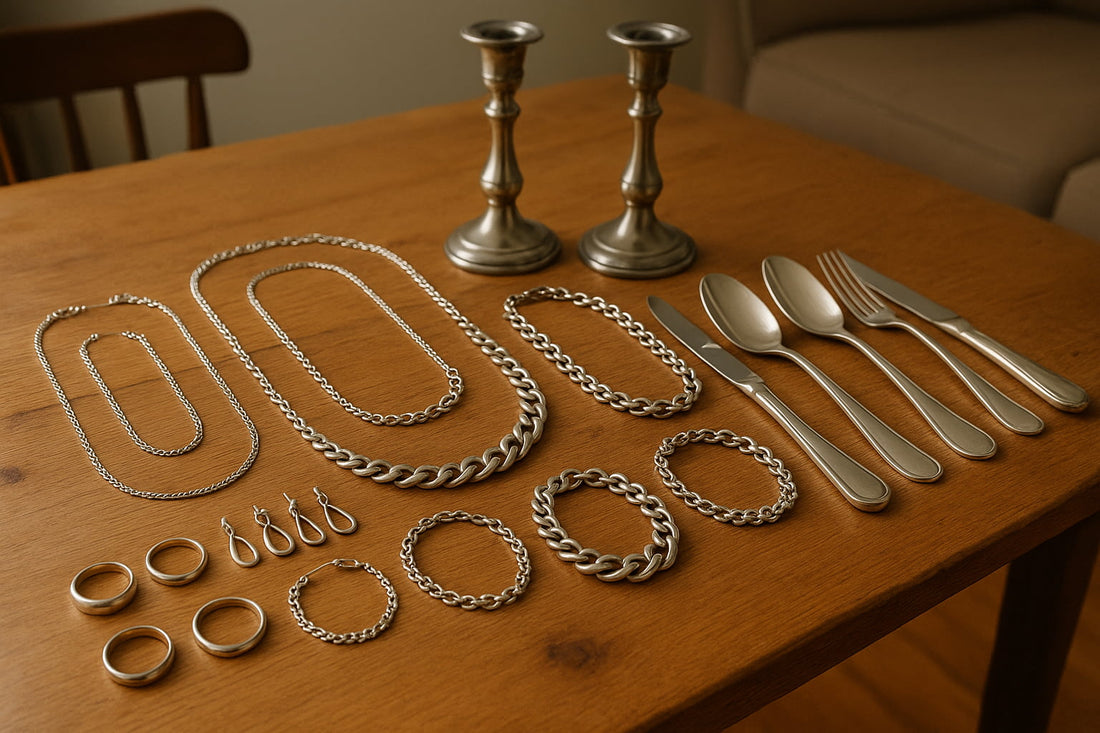
How to Clean Silver Jewellery (A Complete Care Guide)
Silver jewellery needs proper care whether it’s a family heirloom or your personal keepsake. I’m a chemist who owns a few fine pieces myself and I can confirm that silver reacts with airborne pollutants and impurities.

These pollutants - mainly sulphur dioxide (SO₂) and hydrogen sulphide (H₂S) are the main culprits that make silver tarnish. Luckily though with good technique, you can keep your silver radiant for years to come.
Some Silver Polishing Must-Have Tools

- A container for the cleaning solution (like a bowl or beaker).
- Microfibre cleaning cloths to clean and pat things dry.
- Non-metallic stirring rod to mix and move items around (avoid abrasive types).
- A jewellery-specific cleaner (metalware cleaners, silver dips, all purpose cleaner with natural ingredients). Always opt for a gentle formula where possible.
- A soft-bristled brush (optional, but handy for delicate pieces).
Follow These Chemist-Approved Silver Cleaning Steps:

Step 1: Prepare the cleaning solution
Fill your container with lukewarm water, add a jewellery-specific cleaner and dilute it according to label instructions. Stir the cleaner with a non-metallic rod to mix it evenly.
While stirring with a nearby spoon is tempting, non-metal stirrers prevent unwanted chemical reactions with certain cleaners.
Step 2: Test less visible parts of your piece to begin with

Before submerging your entire piece of silver into it, dip a less visible part of your jewellery into the solution first. Wait 1-2 minutes and check for any signs of discoloration or surface changes.
This quick test is to ensure cleaner compatibility, especially if your jewellery has intricate designs, engravings, or gemstones.
Step 3: Soak or wipe (depending on the item)

Before diving in, consider whether what you're cleaning is a delicate item and the condition it's in.
Not sure if it’s delicate?
Items with fine chains, claw-set gemstones, vintage detailing, enamel, pearls, or fragile clasps usually count as delicate. If it looks like it could bend, scratch, or trap moisture easily - treat it with extra care.
Important: The demo video below shows me using firm but controlled motions on sturdy, non-delicate pieces. These techniques are not suitable for finer or more fragile items.
Cleaning Process
Sturdy Jewellery
Place your piece(s) into the solution. If heavily tarnished, submerge for 2–3 minutes first. Agitate your jewellery with a non-metallic mixing rod (as per the demo). Use firm, steady motions to lift the grime.
Delicate Items
Don't soak these. Instead, just dip a microfibre cloth or soft-bristled brush slightly into the cleaning solution. Then, gently wipe or lightly scrub at the silver surface to avoid damaging the finer details.
Note: This delicate cleaning method is not shown in the demo, but it’s the safer route for fragile jewellery.
Special Case: Watches

For your watches, they need to be waterproof and in great condition (with sealed gaskets, crowns, and cases). If you're unsure about how waterproof your watch actually is, don't soak it at all.
Instead: Slightly dampen a microfibre cloth with the solution. Wipe only the metal bracelet or casing. Avoid any areas where water could seep in, such as the crown or crystal edges.
Step 4: Run it under clean lukewarm water
For items you’ve soaked, hook your items out from the murky cleaning solution with the stirring rod and rinse with water to remove any residual cleaner. This goes for wiped items too aside from non-waterproof watches, where you’ll need to take extra care with moisture.
Step 5: Dry and polish
Pat the jewellery dry with a clean, dry microfibre or lint-free cloth until it returns to its natural shining state.
Step 6: Store properly
Once you're done with steps 1 to 5, allow your jewellery to air dry so that no moisture remains and your skin oils won’t stick to the surface.
Once it’s completely dry, wear it as you would normally or store it somewhere safe. A ziplock bag, a cloth pouch, or keeping it away from sunlight all help preserve your silver jewellery.
FAQs People Have
Can harsh chemicals damage silver?
Yes. While silver is a durable element, strong chemicals like ammonia or bleach-based cleaners can still wear it down. Tiny craters and rough spots can form, making the silver look dull, damaged or even change in colour. Milder cleaners are always the preferred options.
How often should I clean silver jewellery?
Clean every 1–2 months for regular wear or when tarnish appears.
Are natural cleaning solutions equally effective for silver tarnish removal?
Absolutely. Modern eco-friendly silver care products are formulated to dissolve tarnish effectively while being much gentler on both the jewellery and the user. Find out if eco friendly cleaning products are worth it.

Is it safe to dip my hands in the cleaning solution to stir?
If you're using a natural silver cleaner, it’s typically okay for direct skin contact. Otherwise, always confirm this by reading the label on the product properly. Wearing gloves just in case is always a smart option.
Can I just use baking soda or toothpaste to clean silver?
Baking soda and toothpaste can work but they’re way more abrasive. Stick to jewellery-specific cleaners for the safest results.
How should I clean a silver watch without risking water damage?
Focus on the parts with actual silver on it. Try to avoid saturating any moving parts with liquid. If the watch is waterproof, there’s more flexibility. But even then, it’s still best to be conservative with moisture exposure.
Conclusion

If you’ve followed along this far, your silver jewellery should be sparkling again. With a tender all purpose cleaner, caring for your collection doesn’t have to be hard. Proper and regular silver care will have your pieces glistening for generations to come.

